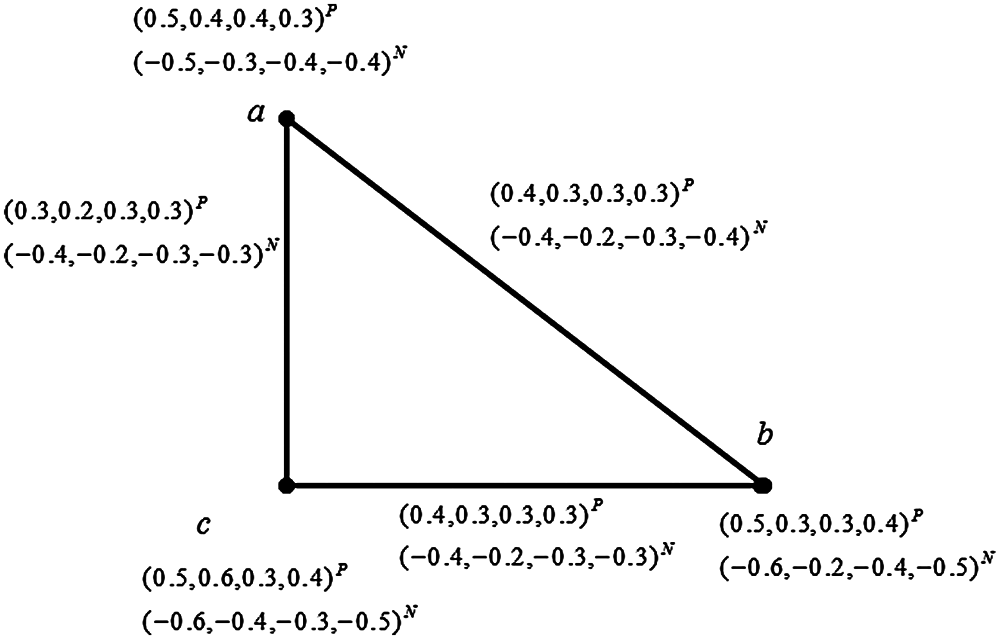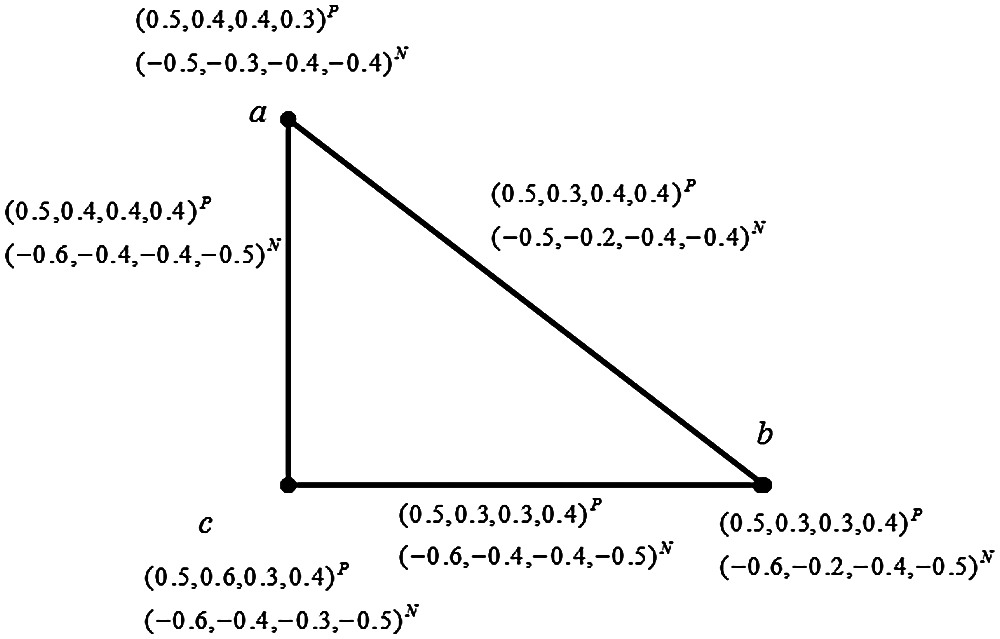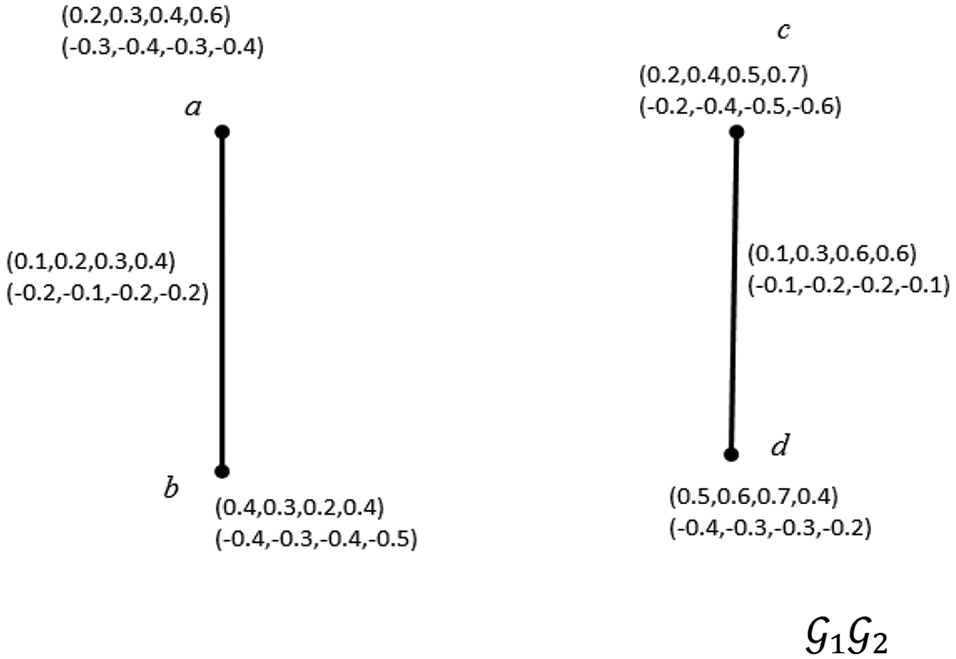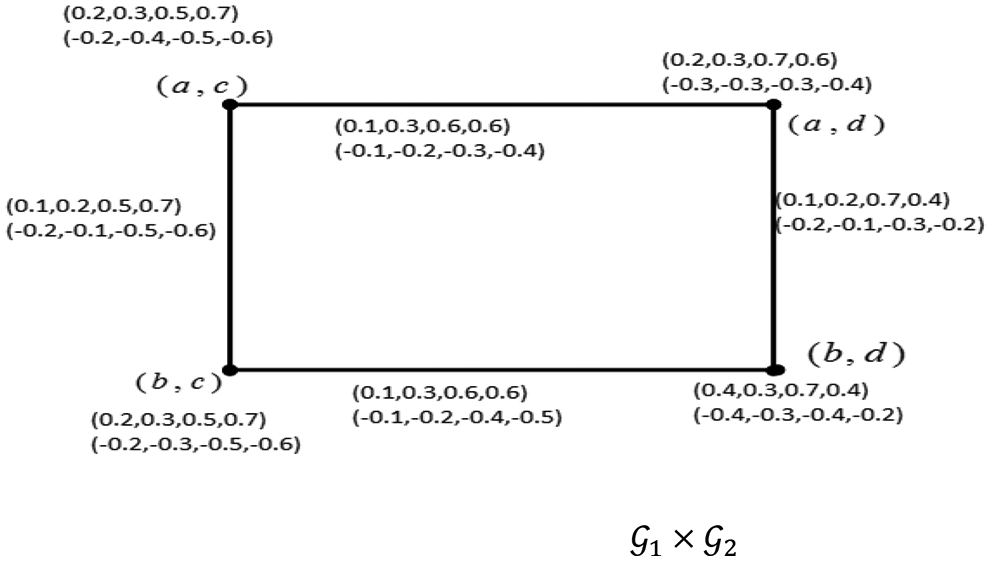[BACK]
 | Computer Modeling in Engineering & Sciences |  |
DOI: 10.32604/cmes.2022.017032
ARTICLE
New Concepts on Quadripartitioned Bipolar Single Valued Neutrosophic Graph
S. Satham Hussain1, G. Muhiuddin2,*, N. Durga3 and D. Al-Kadi4
1PG and Research Department of Mathematics, Jamal Mohamed College (Autonomus), Tiruchirappalli, 620020, India
2Department of Mathematics, University of Tabuk, Tabuk, 71491, Saudi Arabia
3Division of Mathematics, School of Advanced Sciences, Vellore Institute of Technology-Chennai Campus, Chennai, 600127, India
4Department of Mathematics and Statistic, College of Science, Taif University, Taif, 21944, Saudi Arabia
*Corresponding Author: G. Muhiuddin. Email: chishtygm@gmail.com
Received: 27 April 2021; Accepted: 14 July 2021
Abstract: The partition of indeterminacy function of the neutrosophic set into the contradiction part and the ignorance part represent the quadripartitioned single valued neutrosophic set. In this work, the new concept of quadripartitioned bipolar single valued neutrosophic graph is established, and the operations on it are studied. The Cartesian product, cross product, lexicographic product, strong product and composition of quadripartitioned bipolar single valued neutrosophic graph are investigated. The proposed concepts are illustrated with examples.
Keywords: Quadripartitioned bipolar single valued neutrosophic graph; operations of quadripartitioned bipolar single valued neutrosophic graph; Cartesian product
1 Introduction
Bipolar fuzzy sets are more useful, beneficial, and applicable in real-world situations. It deals with incomplete information since they do not take into account indeterminate or contradictory data, which can be found in a variety of systems [1,2], including belief systems and decision-support systems [3,4]. As reality vanishes in a black hole due to Hawking radiation or specific/anti-particular emission, the bipolar domain is the most important condition that persists. In a bipolar fuzzy set, an element with a membership degree of 0 is insignificant to the subsequent property, an element with a membership degree of (0,1] is somewhat satisfied by the property, and an element with a membership degree of [−1,0] is quite satisfied by the implied counter-property. On the other hand, to interpret the degree of true and false membership functions, some restrictions allow only to hold incomplete data, but the handling of indeterminate information remains. Can we see an instance, suppose there are ten patients to check a pandemic during testing. In that time, three patients are having positive, five will have negative, and two are undecided or yet to come. By employing the neutrosophic concepts, it can be expressed as x(0.3,0.2,0.5). For the clear understanding, one can characterize the climate as cold as truth, moderate as indeterminacy and hot as false using a neutrosophic set. Hence the neutrosophic field arises to hold the indeterminacy data as well. It generalizes the aforementioned sets from the philosophical viewpoint. The single-valued neutrosophic set is the generalization of intuitionistic fuzzy sets and is used expediently to deal with real-world problems, especially in decision support [5]. The computation of belief in that element (truth), they disbelieve in that element (falsehood) and the indeterminacy part of that element with the sum of these three components are strictly less than 1 and it is proposed by Smarandache [6] and references therein.
In the case of neutrosophic sets, indeterminacy function is considered as an individual term and each element x is characterized by a truth-membership function TA(x), an indeterminacy membership function IA(x) and a falsity-membership function FA(x), each of that from the non-standard unit interval [0−,1+]. Despite the neutrosophic indeterminacy is independent of the truth and falsity-membership values, but it is more general than the hesitation margin of intuitionistic fuzzy sets. It is not sure whether the indeterminacy values relevant to a particular element correspond to hesitant values about its belonging or not belonging to it. In another way, if a person identifies an indeterminacy membership IA(x) with a specific event x, it becomes difficult to understand whether the person’s degree of uncertainty regarding the event’s occurrence is IA(x) or whether the person’s degree of uncertainty regarding the event’s non-occurrence is IA(x). As a result, some authors prefer to model the indeterminacy’s behaviour in the same way they similar to truth-membership, others may prefer to model it, in the same way, they similar to falsity-membership. Wang et al. [5] initiated the concept of a single-valued neutrosophic set and provide its various properties. It has been widely applied in various fields, such as information fusion in which data are combined from different sensors [7], control theory [8], image processing [9], medical diagnosis [10], decision making [11,12], and graph theory [13–20], etc.
When the indeterminacy portion of the neutrosophic set is divided into two parts, we get four components: ‘Contradiction’ (both true and false) and ‘Unknown’ (neither true nor false), that is T,C,U and F which defines a new set called ‘quadripartitioned single valued neutrosophic set’, introduced by Chatterjee et al. [21]. This study is completely based on “Belnap’s four valued logic” [22] and Smarandache’s “Four Numerical valued neutrosophic logic” [23]. By employing the concept of Quadripartitioned Single Valued Neutrosophic Set (QSVNS), this paper presents the quadripartitioned single-valued neutrosophic graphs. Operations on single-valued neutrosophic graphs are studied in [24]. Further, the operations on neutrosophic vague graphs are discussed in [16]. Authors in [25] studied the bipolar quadripartitioned single-valued neutrosophic sets. In [3,26], the authors extensively studied about the concept of bipolar neutrosophic graphs. Moreover, in [27], bipolar single valued neutrosophic graphs are investigated with its related properties. Motivated by the above-mentioned works, to the best of the authors’ knowledge, there is no work reported on the concepts of bipolar quadripartioned single-valued neutrosophic graphs with the application. More concepts related to this study have been studied in [28–31]. The major contributions in this work are explained as follows:
1. The notions of Quadripartitioned Bipolar Single Valued Neutrosophic Graphs (QBSVNGs) are introduced. This manuscript makes the first attempt in the literature about the concept in neutrosophic graphs.
2. In addition, the complete and strong QBSVNG are defined. The operations like a Cartesian product, cross product, lexicographic product, strong product and the composition of QBSVNGs with their properties are discussed.
3. The proposed work will generalise the existing works in the literature [3,24,25,32].
The paper is organized as follows: The basic needed definitions are given in Preliminaries Section 2 . The QBSVNGs are introduced and the operations are explained in Section 3 .
2 Preliminaries
Definition 2.1 [6] Let X be a space of points (objects), with generic elements in X denoted by x. A single valued neutrosophic set A in X is characterised by truth-membership function TA(x), indeterminacy-membership function IA(x) and falsity-membership-function FA(x).
For each point x in X, TA(x),IA(x),FA(x)∈[0,1]. Also
A={x,TA(x),IA(x),FA(x)} and 0≤TA(x)+IA(x)+FA(x)≤3.
Definition 2.2 [6] A Neutrosophic set A is contained in another neutrosophic set B, (i.e) A⊆B if ∀ x∈X, TA(x)≤TB(x),IA(x)≥IB(x) and FA(x)≥FB(x).
Definition 2.3 [24] A neutrosophic graph is defined as a pair G∗=(V,E) where
(i) V={v1,v2,…,vn} such that TA:V→[0,1], IA:V→[0,1] and FA:V→[0,1] denote the degrees of truth-membership function, indeterminacy function and falsity-membership function, respectively and
0≤TA(v)+IA(v)+FA(v)≤3,∀ v∈V.
(ii) E⊆V×V where TB:E→[0,1], IB:E→[0,1] and FB:E→[0,1] are such that
TB(uv)≤min{TA(u),TA(v)},
IB(uv)≤min{IA(u),IA(v)},
FB(uv)≤max{FA(u),FA(v)},
and 0≤TB(uv)+IB(uv)+FB(uv)≤3,∀ uv∈E.
For more details about the following definitions and results, see the article [21].
Definition 2.4 Let X be a non-empty set. A quadripartitioned neutrosopohic set (QSVNS) A over X characterizes each elements x in X by a truth membership function TA, a contradiction membership function CA, an ignorance membership function UA and a false membership function FA such that for each x∈X,TA,CA,UA,FA∈[0,1] and 0≤TA(x)+CA(x)+UA(x)+FA(x)≤4.
Remark 2.5 A QSVNS A can be decomposed to yield two SVNS, say, At and Ab where the respective membership functions and these sets are defined as
TAt(x)=TA(x)=TAb(x)
IAt(x)=CA(x),IAb(x)=UA(x)
FAt(x)=FA(x)=FAb(x),∀x∈X.
In this respect, we stated that while performing set-theoretic operations over these SVNS, the behaviour of IAt is treated similar to that of TAt while the behaviour of IAb is modelled in a way similar to that of FAb.
Definition 2.6 A QSVNS is said to be an absolute QSVNS, deoted by A, if and only if its membership values are respectivley defined as TA(x)=1, CA(x)=1 , UA(x)=0 and FA(x)=0.
Definition 2.7 Consider two QSVNS A and B over X.A is said to be contained in B, denoted by A⊆B if, and only, if TA(x)≤TB(x), CA(x)≤CB(x), UA(x)≥UB(x) and FA(x)≥FB(x).
Definition 2.8 The complement of a QSVNS A, is denoted by Ac and is defined as
Ac=∑i=1n⟨FA(xi),UA(xi),CA(xi),TA(xi)⟩,∀ xi∈X.
i.e., TAc(xi)=FA(xi),CAc(xi)=UA(xi), UAc(xi)=CA(xi),FAc(xi)=TA(xi),∀ xi∈X.
Definition 2.9 The union of two QSVNS A and B is denoted by A∪B and is defined as
A∪B=∑i=1n⟨TA(xi)∨TB(xi),CA(xi)∨CB(xi)
UA(xi)∧UB(xi),FA(xi)∧FB(xi)⟩/X.
Definition 2.10 The intersection of two QSVNS A and B is denoted by A∩B and is defined as
A∩B=∑i=1n⟨TA(xi)∧TB(xi),CA(xi)∧CB(xi)
UA(xi)∨UB(xi),FA(xi)∨FB(xi)⟩/X.
Definition 2.11 A quadripartitioned single valued bipolar neutrosophic set (QSVBNS) A is X defined as an object of the form:
A=⟨x,(T)AP(x),(C)AP(x),(U)AP(x),(F)AP(x),(T)AN(x),(C)AN(x),(U)AN(x),(F)AN(x):x∈X⟩,
where (T)AP,(C)AP,(U)AP,(F)AP:X→[0,1] and (T)AN,(C)AP,(U)AN,(F)AN:X→[−1,0]. The positive membership degrees (T)AP(x),(C)AP(x),(U)AP(x),(F)AP(x) denote respectively the truth-membership, a contradiction-membership, an ignorance membership degrees and falsity membership of x∈X corresponding to a QSVBNS A. The negative membership degrees (T)AN(x),(C)AN(x),(U)AN(x),(F)AN(x) denote respectively the truth-membership, a contradiction membership, an ignorance membership and falsity membership of x∈X to some explicit counter-property corresponding to a QSVBNS A.
Definition 2.12 Let A and B be two QSVBNS over X. Then A is said to be included in B, denoted by A⊆B, if for each x∈X,
(T)AP(x)≤(T)BP(x),(C)AP(x)≤(C)BP(x), (U)AP(x)≥(T)BP(x),(F)AP(x)≥(F)BP(x), and (T)AN(x)≥(T)BN(x),(C)AN(x)≥(C)BN(x), (U)AN(x)≤(U)BN(x),(F)AN(x)≤(F)BN(x).
Definition 2.13 Two QSVBNS A and B are said to be equal if for each x∈X,
(T)AP(x)=(T)BP(x),(C)AP(x)=(C)BP(x), (U)AP(x)=(U)BP(x),(F)AP(x)=(F)BP(x), and (T)AN(x)=(T)BN(x),(C)AN(x)=(C)BN(x), (U)AN(x)=(U)BN(x),(F)AN(x)=(F)BN(x).
3 Quadripartitioned Bipolar Single Valued Neutrosophic Graphs
In this section, the QBSVNGs are introduced, and its operations like Cartesian product, cross product, lexicographic product, strong product and composition are developed.
Definition 3.1 A QBSVNG of a crisp graph G=(V,E) is defined to be a pair G=(R,S) with R=(RP,RN) and S=(SP,SN), where
(i) the functions (TR)P:V→[0,1], (CR)P:V→[0,1], (UR)P:V→[0,1], (FR)P:V→[0,1] and (TR)N:V→[−1,0], (CR)N:V→[−1,0], (UR)N:V→[−1,0], (FR)N:V→[−1,0] represent the degree of truth membership, contradiction membership, ignorance membership and false membership of the element t∈V, respectively, there is no restriction on the sum 0≤(TR)P(t)+(CR)P(t)+(UR)P(t)+(FR)P(t)≤4, −4≤(TR)N(t)+(CR)N(t)+(UR)N(t)+(FR)N(t)≤0 for all t∈V.
(ii) the functions (TS)P:E⊆V×V→[0,1],(CS)P:E⊆V×V→[0,1],(US)P:E⊆V×V→[0,1],(FS)P:E⊆V×V→[0,1] and (TS)N:E⊆V×V→[−1,0],(CS)N:E⊆V×V→[−1,0],(US)N:E⊆V×V→[−1,0],(FS)N:E⊆V×V→[−1,0] are defined as
(TS)P(ts)≤min{(TR)P(t),(TR)P(s)}
(CS)P(ts)≤min{(CR)P(t),(CR)P(s)}
(US)P(ts)≤max{(UR)P(t),(UR)P(s)}
(FS)P(ts)≤max{(FR)P(t),(FR)P(s)},∀ ts∈E,
(TS)N(ts)≥max{(TR)N(t),(TR)N(s)}
(CS)N(ts)≥max{(CR)N(t),(CR)N(s)}
(US)N(ts)≥min{(UR)N(t),(UR)N(s)}
(FS)N(ts)≥min{(FR)N(t),(FR)N(s)},∀ ts∈E.
There is no restriction on the sum of 0≤(TS)P(ts)+(CS)P(ts)+(US)P(ts)+(FS)P(ts)≤4,
−4≤(TS)N(ts)+(CS)N(ts)+(US)N(ts)+(FS)N(ts)≤0 for all t∈V, for all ts∈E. Here R is the QBSVN vertex set of G and S is the QBSVN edge set of G.
Example 3.1 Consider a crisp graph G=(V,E) such that V={a,b,c} and E={ab,bc,ca} the corresponding QBSVNG G=(R,S) is shown in Fig. 1.

Figure 1: Quadripartitioned bipolar single valued neutrosophic graph
Definition 3.2 A QBSVNG G=(R,S) is called complete if the following conditions are satisfied
(TS)P(ts)=min{(TR)P(t),(TR)P(s)}
(CS)P(ts)=min{(CR)P(t),(CR)P(s)}
(US)P(ts)=max{(UR)P(t),(UR)P(s)}
(FS)P(ts)=max{(FR)P(t),(FR)P(s)},∀ t,s∈V and
(TS)N(ts)=max{(TR)N(t),(TR)N(s)}
(CS)N(ts)=max{(CR)N(t),(CR)N(s)}
(US)N(ts)=min{(UR)N(t),(UR)N(s)}
(FS)N(ts)=min{(FR)N(t),(FR)N(s)},∀ t,s∈V.
Example 3.2 Consider a crisp graph G=(V,E) such that V={a,b,c} and E={ab,bc,ca} the corresponding QBSVNG G=(R,S) is shown in Fig. 2.

Figure 2: Complete bipolar quadripatitioned single valued neutrosophic graph
Definition 3.3 A QBSVNG G=(R,S) is called strong if the following conditions are satisfied:
(TS)P(ts)=min{(TR)P(t),(TR)P(s)}
(CS)P(ts)=min{(CR)P(t),(CR)P(s)}
(US)P(ts)=max{(UR)P(t),(UR)P(s)}
(FS)P(ts)=max{(FR)P(t),(FR)P(s)},∀ ts∈E and
(TS)N(ts)=max{(TR)N(t),(TR)N(s)}
(CS)N(ts)=max{(CR)N(t),(CR)N(s)}
(US)N(ts)=min{(UR)N(t),(UR)N(s)}
(FS)N(ts)=min{(FR)N(t),(FR)N(s)},∀ ts∈E.
Definition 3.4 The Cartesian product of two QBSVNGs, G1 and G2 is denoted by the pair G1×G2=(R1×R2,S1×S2) and defined as
(i) (T)(R1×R2)P(kl)=(T)R1P(k)∧(T)R2P(l)
(C)(R1×R2)P(kl)=(C)R1P(k)∧(C)R2P(l)
(U)(R1×R2)P(kl)=(U)R1P(k)∨(U)R2P(l)
(F)(R1×R2)P(kl)=(F)R1P(k)∨(F)R2P(l)
(T)(R1×R2)N(kl)=(T)R1N(k)∨(T)R2N(l)
(C)(R1×R2)N(kl)=(C)R1N(k)∨(C)R2N(l)
(U)(R1×R2)N(kl)=(U)R1N(k)∧(U)R2N(l)
(F)(R1×R2)N(kl)=(F)R1N(k)∧(F)R2N(l)
for all (k,l)∈R1×R2.
The membership value of the edges in G1×G2 can be calculated as
(ii) (T)(S1×S2)P(kl1)(kl2)=(T)R1P(k)∧(T)S2P(l1l2)
(C)(S1×S2)P(kl1)(kl2)=(C)R1P(k)∧(C)S2P(l1l2)
(U)(S1×S2)P(kl1)(kl2)=(U)R1P(k)∨(U)S2P(l1l2)
(F)(S1×S2)P(kl1)(kl2)=(F)R1P(k)∨(F)S2P(l1l2)
(T)(S1×S2)N(kl1)(kl2)=(T)R1N(k)∨(T)S2N(l1l2)
(C)(S1×S2)N(kl1)(kl2)=(C)R1N(k)∨(C)S2N(l1l2)
(U)(S1×S2)N(kl1)(kl2)=(U)R1N(k)∧(U)S2N(l1l2)
(F)(S1×S2)N(kl1)(kl2)=(F)R1N(k)∧(F)S2N(l1l2)
for all k∈R1,l1l2∈S2.
(iii) (T)(S1×S2)P(k1l)(k2l)=(T)R2P(l)∧(T)S1P(k1k2)
(C)(S1×S2)P(k1l)(k2l)=(C)R2P(l)∧(C)S1P(k1k2)
(U)(S1×S2)P(k1l)(k2l)=(U)R2P(l)∨(U)S1P(k1k2)
(F)(S1×S2)P(k1l)(k2l)=(F)R2P(l)∨(F)S1P(k1k2)
(T)(S1×S2)N(k1l)(k2l)=(T)R2N(l)∨(T)S1N(k1k2)
(C)(S1×S2)N(k1l)(k2l)=(C)R2N(l)∨(C)S1N(k1k2)
(U)(S1×S2)N(k1l)(k2l)=(U)R2N(l)∧(U)S1N(k1k2)
(F)(S1×S2)N(k1l)(k2l)=(F)R2N(l)∧(F)S1N(k1k2)
for all l∈R2,k1k2∈S1.
Example 3.3 Consider two QBSVNG G1 and G2 as shown in Fig. 3. Then Cartesian product of G1×G2 is shown in Fig. 4.

Figure 3: G1 and G1 Two bipolar quadripatitioned single valued neutrosophic graph

Figure 4: Cartesian product of quadripatitioned single valued neutrosophic graph
Proposition 3.5 The Cartesian product G1×G2=(R1×R2,S1×S2) of two QBSVNGs G1 and G2 is also the QBSVNG of G1×G2.
Proof. We consider two cases.
Case 1: for k∈R1,l1l2∈S2,
(T)(S1×S2)P((kl1)(kl2))=(T)R1P(k)∧(T)S2P(l1l2)
≤(T)R1P(k)∧[(T)R2P(l1)∧(T)R2P(l2)]
=[(T)R1P(k)∧(T)R2P(l1)]∧[(T)R1P(k)∧(T)R2P(l2)]
=(T)(R1×R2)P(k,l1)∧(T)(R1×R2)P(k,l2)
(C)(S1×S2)P((kl1)(kl2))=(C)R1P(k)∧(C)S2P(l1l2)
≤(C)R1P(k)∧[(C)R2P(l1)∧(C)R2P(l2)]
=[(C)R1P(k)∧(C)R2P(l1)]∧[(C)R1P(k)∧(C)R2P(l2)]
=(C)(R1×R2)P(k,l1)∧(C)(R1×R2)P(k,l2)
(U)(S1×S2)P((kl1)(kl2))=(U)R1P(k)∨(U)S2P(l1l2)
≤(U)R1P(k)∨[(U)R2P(l1)∨(U)R2P(l2)]
=[(U)R1P(k)∨(U)R2P(l1)]∨[(U)R1P(k)∨(U)R2P(l2)]
=(U)(R1×R2)P(k,l1)∨(U)(R1×R2)P(k,l2)
(F)(S1×S2)P((kl1)(kl2))=(F)R1P(k)∨(F)S2P(l1l2)
≤(F)R1P(k)∨[(F)R2P(l1)∨(F)R2P(l2)]
=[(F)R1P(k)∨(F)R2P(l1)]∨[(F)R1P(k)∨(F)R2P(l2)]
=(F)(R1×R2)P(k,l1)∨(F)(R1×R2)P(k,l2)
for all (kl1,kl2)∈G1×G2.
Case 2: for k∈R2,l1l2∈S1.
(T)(S1×S2)P((l1k)(l2k))=(T)R2P(k)∧(T)S1P(l1l2)
≤(T)R2P(k)∧[(T)R1P(l1)∧(T)R1P(l2)]
=[(T)R2P(k)∧(T)R2P(l1)]∧[(T)R2P(k)∧(T)R1P(l2)]
=(T)(R1×R2)P(l1,k)∧(T)(R1×R2)P(l2,k)
(C)(S1×S2)P((l1k)(l2k))=(C)R2P(k)∧(C)S1P(l1l2)
≤(C)R2P(k)∧[(C)R1P(l1)∧(C)R1P(l2)]
=[(C)R2P(k)∧(C)R2P(l1)]∧[(C)R2P(k)∧(C)R1P(l2)]
=(C)(R1×R2)P(l1,k)∧(C)(R1×R2)P(l2,k)
(U)(S1×S2)P((l1k)(l2k))=(U)R2P(k)∨(U)S1P(l1l2)
≤(U)R2P(k)∨[(U)R1P(l1)∨(U)R1P(l2)]
=[(U)R2P(k)∨(U)R2P(l1)]∨[(U)R2P(k)∨(U)R1P(l2)]
=(U)(R1×R2)P(l1,k)∨(U)(R1×R2)P(l2,k)
(F)(S1×S2)P((l1k)(l2k))=(F)R2P(k)∨(F)S1P(l1l2)
≤(F)R2P(k)∨[(F)R1P(l1)∨(F)R1P(l2)]
=[(F)R2P(k)∨(F)R2P(l1)]∨[(F)R2P(k)∨(F)R1P(l2)]
=(F)(R1×R2)P(l1,k)∨(F)(R1×R2)P(l2,k),
for all (l1k,l2k)∈G1×G2. Likewise, one can prove the negative part.
Definition 3.6 The cross product of two QBSVNGs G1 and G2 is denoted by the pair G1⋆G2=(R1⋆R2,S1⋆S2) and defined as:
(i) (T)(R1⋆R2)P(kl)=(T)R1P(k)∧(T)R2P(l)
(C)(R1⋆R2)P(kl)=(C)R1P(k)∧(C)R2P(l)
(U)(R1⋆R2)P(kl)=(U)R1P(k)∨(U)R2P(l)
(F)(R1⋆R2)P(kl)=(F)R1P(k)∨(F)R2P(l)
(T)(R1⋆R2)N(kl)=(T)R1N(k)∨(T)R2N(l)
(C)(R1⋆R2)N(kl)=(C)R1N(k)∨(C)R2N(l)
(U)(R1⋆R2)N(kl)=(U)R1N(k)∧(U)R2N(l)
(F)(R1⋆R2)N(kl)=(F)R1N(k)∧(F)R2N(l)
for all (k,l)∈R1⋆R2.
(ii) (T)(S1⋆S2)P(k1l1)(k2l2)=(T)S1P(k1k2)∧(T)S2P(l1l2)
(C)(S1⋆S2)P(k1l1)(k2l2)=(C)S1P(k1k2)∧(C)S2P(l1l2)
(U)(S1⋆S2)P(k1l1)(k2l2)=(U)S1P(k1k2)∨(U)S2P(l1l2)
(F)(S1⋆S2)P(k1l1)(k2l2)=(F)S1P(k1k2)∨(F)S2P(l1l2)
(T)(S1⋆S2)N(k1l1)(k2l2)=(T)S1N(k1k2)∨(T)S2N(l1l2)
(C)(S1⋆S2)N(k1l1)(k2l2)=(C)S1N(k1k2)∨(C)S2N(l1l2)
(U)(S1⋆S2)N(k1l1)(k2l2)=(U)S1N(k1k2)∧(U)S2N(l1l2)
(F)(S1⋆S2)N(k1l1)(k2l2)=(F)S1N(k1k2)∧(F)S2N(l1l2),
for all k1k2∈S1,l1l2∈S2.
Proposition 3.7 The cross product G1⋆G2=(R1⋆R2,S1⋆S2) of two QBSVNGs G1 and G2 is also the QBSVNG of G1⋆G2.
Proof. For all (k1l1,k2l2)∈G1⋆G2,
(T)(S1⋆S2)P((k1l1)(k2l2))=(T)S1P(k1k2)∧(T)S2P(l1l2)
≤[(T)R1P(k1)∧(T)R1P(k2)]∧[(T)R2P(l1)∧(T)R2P(l2)]
=[(T)R1P(k1)∧(T)R2P(l1)]∧[(T)R1P(k2)∧(T)R2P(l2)]
=(T)(R1⋆R2)P(k1,l1)∧(T)(R1⋆R2)P(k2,l2)
(C)(S1⋆S2)P((k1l1)(k2l2))=(C)S1P(k1k2)∧(C)S2P(l1l2)
≤[(C)R1P(k1)∧(C)R1P(k2)]∧[(C)R2P(l1)∧(C)R2P(l2)]
=[(C)R1P(k1)∧(C)R2P(l1)]∧[(C)R1P(k2)∧(C)R2P(l2)]
=(C)(R1⋆R2)P(k1,l1)∧(C)(R1⋆R2)P(k2,l2)
(U)(S1⋆S2)P((k1l1)(k2l2))=(U)S1P(k1k2)∨(U)S2P(l1l2)
≤[(U)R1P(k1)∨(U)R1P(k2)]∨[(U)R2P(l1)∨(U)R2P(l2)]
=[(U)R1P(k1)∨(U)R2P(l1)]∨[(U)R1P(k2)∨(U)R2P(l2)]
=(U)(R1⋆R2)P(k1,l1)∨(U)(R1⋆R2)P(k2,l2)
(F)(S1⋆S2)P((k1l1)(k2l2))=(F)S1P(k1k2)∨(F)S2P(l1l2)
≤[(F)R1P(k1)∨(F)R1P(k2)]∨[(F)R2P(l1)∨(F)R2P(l2)]
=[(F)R1P(k1)∨(F)R2P(l1)]∨[(F)R1P(k2)∨(F)R2P(l2)]
=(F)(R1⋆R2)P(k1,l1)∨(F)(R1⋆R2)P(k2,l2).
Similarly, one can prove the negative part. This completes the proof.
Definition 3.8 The lexicographic product of two QBVNGs G1 and G2 is denoted by the pair G1⋅G2=(R1⋅R2,S1⋅S2) and defined as
(i) (T)(R1⋅R2)P(kl)=(T)R1P(k)∧(T)R2P(l)
(C)(R1⋅R2)P(kl)=(C)R1P(k)∧(C)R2P(l)
(U)(R1⋅R2)P(kl)=(U)R1P(k)∨(U)R2P(l)
(F)(R1⋅R2)P(kl)=(F)R1P(k)∨(F)R2P(l)
(T)(R1⋅R2)N(kl)=(T)R1N(k)∨(T)R2N(l)
(C)(R1⋅R2)N(kl)=(C)R1N(k)∨(C)R2N(l)
(U)(R1⋅R2)N(kl)=(U)R1N(k)∧(U)R2N(l)
(F)(R1⋅R2)N(kl)=(F)R1N(k)∧(F)R2N(l)
for all (k,l)∈R1⋅R2.
(ii) (T)(S1⋅S2)P(kl1)(kl2)=(T)R1P(k)∧(T)S2P(l1l2)
(C)(S1⋅S2)P(kl1)(kl2)=(C)R1P(k)∧(C)S2P(l1l2)
(U)(S1⋅S2)P(kl1)(kl2)=(U)R1P(k)∨(U)S2P(l1l2)
(F)(S1⋅S2)P(kl1)(kl2)=(F)R1P(k)∨(F)S2P(l1l2),
(T)(S1⋅S2)N(kl1)(kl2)=(T)R1N(k)∧(T)S2N(l1l2)
(C)(S1⋅S2)N(kl1)(kl2)=(C)R1N(k)∧(C)S2N(l1l2)
(U)(S1⋅S2)N(kl1)(kl2)=(U)R1N(k)∨(U)S2N(l1l2)
(F)(S1⋅S2)N(kl1)(kl2)=(F)R1N(k)∨(F)S2N(l1l2)
for all k∈R1,l1l2∈S2.
(iii) (T)(S1⋅S2)P(k1l1)(k2l2)=(T)S1P(k1k2)∧(T)S2P(l1l2)
(C)(S1⋅S2)P(k1l1)(k2l2)=(C)S1P(k1k2)∧(C)S2(l1l2)
(U)(S1⋅S2)P(k1l1)(k2l2)=(U)S1P(k1k2)∨(U)S2P(l1l2)
(F)(S1⋅S2)P(k1l1)(k2l2)=(F)S1P(k1k2)∨(F)S2P(l1l2),
(T)(S1⋅S2)N(k1l1)(k2l2)=(T)S1N(k1k2)∨(T)S2N(l1l2)
(C)(S1⋅S2)N(k1l1)(k2l2)=(C)S1N(k1k2)∨(C)S2N(l1l2)
(U)(S1⋅S2)N(k1l1)(k2l2)=(U)S1N(k1k2)∧(U)S2N(l1l2)
(F)(S1⋅S2)N(k1l1)(k2l2)=(F)S1N(k1k2)∧(F)S2N(l1l2),
for all k1k2∈S1,l1l2∈S2.
Proposition 3.9 The lexicographic product G1⋅G2=(R1⋅R2,S1⋅S2) of two QBSVNGs G1 and G2 is also the QBSVNG of G1⋅G2.
Proof. We have two cases.
Case 1: For k∈R1,l1l2∈S2,
(T)(S1⋅S2)P((kl1)(kl2))=(T)R1P(k)∧(T)S2P(l1l2)
≤(T)R1P(k)∧[(T)R2P(l1)∧(T)R2P(l2)]
=[(T)R1P(k)∧(T)R2P(l1)]∧[(T)R1P(k)∧(T)R2P(l2)]
=(T)(R1⋅R2)P(k,l1)∧(T)(R1⋅R2)P(k,l2)
(C)(S1⋅S2)P((kl1)(kl2))=(C)R1P(k)∧(C)S2P(l1l2)
≤(C)R1P(k)∧[(C)R2P(l1)∧(C)R2P(l2)]
=[(C)R1P(k)∧(C)R2P(l1)]∧[(C)R1P(k)∧(C)R2P(l2)]
=(C)(R1⋅R2)P(k,l1)∧(C)(R1⋅R2)P(k,l2)
(U)(S1⋅S2)P((kl1)(kl2))=(U)R1P(k)∨(U)S2P(l1l2)
≤(U)R1P(k)∨[(U)R2P(l1)∨(U)R2P(l2)]
=[(U)R1P(k)∨(U)R2P(l1)]∨[(U)R1P(k)∨(U)R2P(l2)]
=(U)(R1⋅R2)P(k,l1)∨(U)(R1⋅R2)P(k,l2)
(F)(S1⋅S2)P((kl1)(kl2))=(F)R1P(k)∨(F)S2P(l1l2)
≤(F)R1P(k)∨[(F)R2P(l1)∨(F)R2P(l2)]
=[(F)R1P(k)∨(F)R2P(l1)]∨[(F)R1P(k)∨(F)R2P(l2)]
=(F)(R1⋅R2)P(k,l1)∨(F)(R1⋅R2)P(k,l2),
for all (kl1,kl2)∈S1⋅S2.
Case 2: For all k1l1∈S1,k2l2∈S2,
(T)(S1⋅S2)P((k1l1)(k2l2))=(T)S1P(k1k2)∧(T)S2P(l1l2)
≤[(T)R1P(k1)∧(T)R1P(k2)]∧[(T)R2P(l1)∧(T)R2P(l2)]
=[(T)R1P(k1)∧(T)R2P(l1)]∧[(T)R1P(k2)∧(T)R2P(l2)]
=(T)(R1⋅R2)P(k1,l1)∧(T)(R1⋅R2)P(k2,l2)
(C)(S1⋅S2)P((k1l1)(k2l2))=(C)S1P(k1k2)∧(C)S2P(l1l2)
≤[(C)R1P(k1)∧(C)R1P(k2)]∧[(C)R2P(l1)∧(C)R2P(l2)]
=[(C)R1P(k1)∧(C)R2P(l1)]∧[(C)R1P(k2)∧(C)R2P(l2)]
=(C)(R1⋅R2)P(k1,l1)∧(C)(R1⋅R2)P(k2,l2)
(U)(S1⋅S2)P((k1l1)(k2l2))=(U)S1P(k1k2)∨(U)S2P(l1l2)
≤[(U)R1P(k1)∨(U)R1P(k2)]∨[(U)R2P(l1)∨(U)R2P(l2)]
=[(U)R1P(k1)∨(U)R2P(l1)]∨[(U)R1P(k2)∨(U)R2P(l2)]
=(U)(R1⋅R2)P(k1,l1)∨(U)(R1⋅R2)P(k2,l2)
(F)(S1⋅S2)P((k1l1)(k2l2))=(F)S1P(k1k2)∨(F)S2P(l1l2)
≤[(F)R1P(k1)∨(F)R1P(k2)]∨[(F)R2P(l1)∨(F)R2P(l2)]
=[(F)R1P(k1)∨(F)R2P(l1)]∨[(F)R1P(k2)∨(F)R2P(l2)]
=(F)(R1⋅R2)P(k1,l1)∨(F)(R1⋅R2)P(k2,l2),
for all (k1l1,k2l2)∈R1⋅R2. Likewise, one can prove the negative part. This completes the proof.
Definition 3.10 The strong product of two QBSVNGs G1 and G2 is denoted by the pair G1⊠G2=(R1⊠R2,S1⊠S2) and defined as
(i) (T)(R1⊠R2)P(kl)=(T)R1P(k)∧(T)R2P(l)
(C)(R1⊠R2)P(kl)=(C)R1P(k)∧(C)R2P(l)
(U)(R1⊠R2)P(kl)=(U)R1P(k)∨(U)R2P(l)
(F)(R1⊠R2)P(kl)=(F)R1P(k)∨(F)R2P(l)
(T)(R1⊠R2)N(kl)=(T)R1N(k)∨(T)R2N(l)
(C)(R1⊠R2)N(kl)=(C)R1N(k)∨(C)R2N(l)
(U)(R1⊠R2)N(kl)=(U)R1N(k)∧(U)R2N(l)
(F)(R1⊠R2)N(kl)=(F)R1N(k)∧(F)R2N(l),
for all (k,l)∈R1⊠R2.
(ii) (T)(S1⊠S2)P(kl1)(kl2)=(T)R1P(k)∧(T)S2P(l1l2)
(C)(S1⊠S2)P(kl1)(kl2)=(C)R1P(k)∧(C)S2P(l1l2)
(U)(S1⊠S2)P(kl1)(kl2)=(U)R1P(k)∨(U)S2P(l1l2)
(F)(S1⊠S2)P(kl1)(kl2)=(F)R1P(k)∨(F)S2P(l1l2)
(T)(S1⊠S2)N(kl1)(kl2)=(T)R1N(k)∨(T)S2N(l1l2)
(C)(S1⊠S2)N(kl1)(kl2)=(C)R1N(k)∨(C)S2N(l1l2)
(U)(S1⊠S2)N(kl1)(kl2)=(U)R1N(k)∧(U)S2P(l1l2)
(F)(S1⊠S2)N(kl1)(kl2)=(F)R1N(k)∧(F)S2N(l1l2),
for all k∈R1,l1l2∈S2.
(iii) (T)(S1⊠S2)P(k1l)(k2l)=(T)R2P(l)∧(T)S1P(k1k2)
(C)(S1⊠S2)P(k1l)(k2l)=(C)R2P(l)∧(C)S1P(k1k2)
(U)(S1⊠S2)P(k1l)(k2l)=(U)R2P(l)∨(U)S1P(k1k2)
(F)(S1⊠S2)P(k1l)(k2l)=(F)R2P(l)∨(F)S1P(k1k2)
(T)(S1⊠S2)N(k1l)(k2l)=(T)R2N(l)∨(T)S1N(k1k2)
(C)(S1⊠S2)N(k1l)(k2l)=(C)R2N(l)∨(C)S1N(k1k2)
(U)(S1⊠S2)N(k1l)(k2l)=(U)R2N(l)∧(U)S1N(k1k2)
(F)(S1⊠S2)N(k1l)(k2l)=(F)R2N(l)∧(F)S1N(k1k2),
for all l∈R2,k1k2∈S1.
(iv)(T)(S1⊠S2)P(k1l1)(k2l2)=(T)S1P(k1k2)∧(T)S2P(l1l2)
(C)(S1⊠S2)P(k1l1)(k2l2)=(C)S1P(k1k2)∧(C)S2P(l1l2)
(U)(S1⊠S2)P(k1l1)(k2l2)=(U)S1P(k1k2)∨(U)S2P(l1l2)
(F)(S1⊠S2)P(k1l1)(k2l2)=(F)S1P(k1k2)∨(F)S2P(l1l2)
(T)(S1⊠S2)N(k1l1)(k2l2)=(T)S1N(k1k2)∨(T)S2N(l1l2)
(C)(S1⊠S2)N(k1l1)(k2l2)=(C)S1N(k1k2)∨(C)S2N(l1l2)
(U)(S1⊠S2)N(k1l1)(k2l2)=(U)S1N(k1k2)∧(U)S2N(l1l2)
(F)(S1⊠S2)N(k1l1)(k2l2)=(F)S1N(k1k2)∧(F)S2N(l1l2),
for all k1k2∈S1,l1l2∈S2.
Proposition 3.11 The strong product G1⊠G2=(R1⊠R2,S1⊠S2) of two QBSVNG G1 and G2 is also the QBSVNG of G1⊠G2.
Proof. We have three cases.
Case 1: For k∈R1,l1l2∈S2,
(T)(S1⊠S2)P((kl1)(kl2))=(T)R1P(k)∧(T)S2P(l1l2)
≤(T)R1P(k)∧[(T)R2P(l1)∧(T)R2P(l2)]
=[(T)R1P(k)∧(T)R2P(l1)]∧[(T)R1P(k)∧(T)R2P(l2)]
=(T)(R1⊠R2)P(k,l1)∧(T)(R1⊠R2)P(k,l2)
(C)(S1⊠S2)P((kl1)(kl2))=(C)R1P(k)∧(C)S2P(l1l2)
≤(C)R1P(k)∧[(C)R2P(l1)∧(C)R2P(l2)]
=[(C)R1P(k)∧(C)R2P(l1)]∧[(C)R1P(k)∧(C)R2P(l2)]
=(C)(R1⊠R2)P(k,l1)∧(C)(R1⊠R2)P(k,l2)
(U)(S1⊠S2)P((kl1)(kl2))=(U)R1P(k)∨(U)S2P(l1l2)
≤(U)R1P(k)∨[(U)R2P(l1)∨(U)R2P(l2)]
=[(U)R1P(k)∨(U)R2P(l1)]∨[(U)R1P(k)∨(U)R2P(l2)]
=(U)(R1⊠R2)P(k,l1)∨(U)(R1⊠R2)P(k,l2)
(F)(S1⊠S2)P((kl1)(kl2))=(F)R1P(k)∨(F)S2P(l1l2)
≤(F)R1P(k)∨[(F)R2P(l1)∨(F)R2P(l2)]
=[(F)R1P(k)∨(F)R2P(l1)]∨[(F)R1P(k)∨(F)R2P(l2)]
=(F)(R1⊠R2)P(k,l1)∨(F)(R1⊠R2)P(k,l2),
for all (kl1,kl2)∈R1⊠R2.
Case 2: For k∈R2,l1l2∈S1.
(T)(S1⊠S2)P((l1k)(l2k))=(T)R2P(k)∧(T)S1P(l1l2)
≤(T)R2P(k)∧[(T)R1P(l1)∧(T)R1P(l2)]
=[(T)R2P(k)∧(T)R2P(l1)]∧[(T)R2P(k)∧(T)R1P(l2)]
=(T)(R1⊠R2)P(l1,k)∧(T)(R1⊠R2)P(l2,k)
(C)(S1⊠S2)P((l1k)(l2k))=(C)R2P(k)∧(C)S1P(l1l2)
≤(C)R2P(k)∧[(C)R1P(l1)∧(C)R1P(l2)]
=[(C)R2P(k)∧(C)R2P(l1)]∧[(C)R2P(k)∧(C)R1P(l2)]
=(C)(R1⊠R2)P(l1,k)∧(C)(R1⊠R2)P(l2,k)
(U)(S1⊠S2)P((l1k)(l2k))=(U)R2P(k)∨(U)S1P(l1l2)
≤(U)R2P(k)∨[(U)R1P(l1)∨(U)R1P(l2)]
=[(U)R2P(k)∨(U)R2P(l1)]∨[(U)R2P(k)∨(U)R1P(l2)]
=(U)(R1⊠R2)P(l1,k)∨(U)(R1⊠R2)P(l2,k)
(F)(S1⊠S2)P((l1k)(l2k))=(F)R2P(k)∨(F)S1P(l1l2)
≤(F)R2P(k)∨[(F)R1P(l1)∨(F)R1P(l2)]
=[(F)R2P(k)∨(F)R2P(l1)]∨[(F)R2P(k)∨(F)R1P(l2)]
=(F)(R1⊠R2)P(l1,k)∨(F)(R1⊠R2)P(l2,k),
for all (l1k,l2k)∈G1⊠G2.
Case 3: For all k1l1∈S1,k2l2∈S2,
(T)(S1⊠S2)P((k1l1)(k2l2))=(T)S1P(k1k2)∧(T)S2P(l1l2)
≤[(T)R1P(k1)∧(T)R1P(k2)]∧[(T)R2P(l1)∧(T)R2P(l2)]
=[(T)R1P(k1)∧(T)R2P(l1)]∧[(T)R1P(k2)∧(T)R2P(l2)]
=(T)(R1⊠R2)P(k1,l1)∧(T)(R1⊠R2)P(k2,l2)
(C)(S1⊠S2)P((k1l1)(k2l2))=(C)S1P(k1k2)∧(C)S2P(l1l2)
≤[(C)R1P(k1)∧(C)R1P(k2)]∧[(C)R2P(l1)∧(C)R2P(l2)]
=[(C)R1P(k1)∧(C)R2P(l1)]∧[(C)R1P(k2)∧(C)R2P(l2)]
=(C)(R1⊠R2)P(k1,l1)∧(C)(R1⊠R2)P(k2,l2)
(U)(S1⊠S2)P((k1l1)(k2l2))=(U)S1P(k1k2)∨(U)S2P(l1l2)
≤[(U)R1P(k1)∨(U)R1P(k2)]∨[(U)R2P(l1)∨(U)R2P(l2)]
=[(U)R1P(k1)∨(U)R2P(l1)]∨[(U)R1P(k2)∨(U)R2P(l2)]
=(U)(R1⊠R2)P(k1,l1)∨(U)(R1⊠R2)P(k2,l2)
(F)(S1⊠S2)P((k1l1)(k2l2))=(F)S1P(k1k2)∨(F)S2P(l1l2)
≤[(F)R1P(k1)∨(F)R1P(k2)]∨[(F)R2P(l1)∨(F)R2P(l2)]
=[(F)R1P(k1)∨(F)R2P(l1)]∨[(F)R1P(k2)∨(F)R2P(l2)]
=(F)(R1⊠R2)P(k1,l1)∨(F)(R1⊠R2)P(k2,l2),
for all (k1l1,k2l2)∈R1⊠R2. Likewise, one can prove the negative part. This completes the proof.
Definition 3.12 The composition of two QBSVNGs G1 and G2 is denoted by the pair G1∘G2=(R1∘R2,S1∘S2) and defined as
(i) (T)(R1∘R2)P(kl)=(T)R1P(k)∧(T)R2P(l)
(C)(R1∘R2)P(kl)=(C)R1P(k)∧(C)R2P(l)
(U)(R1∘R2)P(kl)=(U)R1P(k)∨(U)R2P(l)
(F)(R1∘R2)P(kl)=(F)R1P(k)∨(F)R2P(l)
(T)(R1∘R2)N(kl)=(T)R1N(k)∨(T)R2N(l)
(C)(R1∘R2)N(kl)=(C)R1N(k)∨(C)R2N(l)
(U)(R1∘R2)N(kl)=(U)R1N(k)∧(U)R2N(l)
(F)(R1∘R2)N(kl)=(F)R1N(k)∧(F)R2N(l),
for all (k,l)∈R1∘R2.
(ii) (T)(S1∘S2)P(kl1)(kl2)=(T)R1P(k)∧(T)S2P(l1l2)
(C)(S1∘S2)P(kl1)(kl2)=(C)R1P(k)∧(C)S2P(l1l2)
(U)(S1∘S2)P(kl1)(kl2)=(U)R1P(k)∨(U)S2P(l1l2)
(F)(S1∘S2)P(kl1)(kl2)=(F)R1P(k)∨(F)S2P(l1l2)
(T)(S1∘S2)N(kl1)(kl2)=(T)R1N(k)∨(T)S2N(l1l2)
(C)(S1∘S2)N(kl1)(kl2)=(C)R1N(k)∨(C)S2N(l1l2)
(U)(S1∘S2)N(kl1)(kl2)=(U)R1N(k)∧(U)S2N(l1l2)
(F)(S1∘S2)N(kl1)(kl2)=(F)R1N(k)∧(F)S2N(l1l2),
for all k∈R1,l1l2∈S2.
(iii) (T)(S1∘S2)P(k1l)(k2l)=(T)R2P(l)∧(T)S1P(k1k2)
(C)(S1∘S2)P(k1l)(k2l)=(C)R2P(l)∧(C)S1P(k1k2)
(U)(S1∘S2)P(k1l)(k2l)=(U)R2P(l)∨(U)S1P(k1k2)
(F)(S1∘S2)P(k1l)(k2l)=(F)R2P(l)∨(F)S1P(k1k2)
(T)(S1∘S2)N(k1l)(k2l)=(T)R2N(l)∨(T)S1N(k1k2)
(C)(S1∘S1)N(k1l)(k2l)=(C)R2N(l)∨(C)S1N(k1k2)
(U)(S1∘S2)N(k1l)(k2l)=(U)R2N(l)∧(U)S1N(k1k2)
(F)(S1∘S2)N(k1l)(k2l)=(F)R2N(l)∧(F)S1N(k1k2),
for all l∈R2,k1k2∈S1.
(iv)(T)(S1∘S2)P(k1l1)(k2l2)=(T)S1P(k1k2)∧(T)R2P(l1)∧(T)R2P(l2)
(C)(S1∘S2)P(k1l1)(k2l2)=(C)S1P(k1k2)∧(C)R2P(l1)∧(C)R2P(l2)
(U)(S1∘S2)P(k1l1)(k2l2)=(U)S1P(k1k2)∨(U)R2P(l1)∨(U)R2P(l2)
(F)(S1∘S2)P(k1l1)(k2l2)=(F)S1P(k1k2)∨(F)R2P(l1)∨(F)R2P(l2)
(T)(S1∘S2)N(k1l1)(k2l2)=(T)S1N(k1k2)∨(T)R2N(l1)∨(T)R2N(l2)
(C)(S1∘S2)N(k1l1)(k2l2)=(C)S1N(k1k2)∨(C)R2N(l1)∨(C)R2N(l2)
(U)(S1∘S2)N(k1l1)(k2l2)=(U)S1N(k1k2)∧(U)R2N(l1)∧(U)R2N(l2)
(F)(S1∘S2)N(k1l1)(k2l2)=(F)S1N(k1k2)∧(F)R2N(l1)∧(F)R2N(l2),
for all k1k2∈S1,l1l2∈S2.
Proposition 3.13 The composition G1∘G2=(R1∘R2,S1∘S2) of two QBSVNG, G1 and G2 is also the QBSVNG of G1∘G2.
Proof. We divide the proof into three cases:
Case 1: For k∈R1,l1l2∈S2,
(T)(S1∘S2)P((kl1)(kl2))=(T)R1P(k)∧(T)S2P(l1l2)
≤(T)R1P(k)∧[(T)R2P(l1)∧(T)R2P(l2)]
=[(T)R1P(k)∧(T)R2P(l1)]∧[(T)R1P(k)∧(T)R2P(l2)]
=(T)(R1∘R2)P(k,l1)∧(T)(R1∘R2)P(k,l2)
(C)(S1∘S2)P((kl1)(kl2))=(C)R1P(k)∧(C)S2P(l1l2)
≤(C)R1P(k)∧[(C)R2P(l1)∧(C)R2P(l2)]
=[(C)R1P(k)∧(C)R2P(l1)]∧[(C)R1P(k)∧(C)R2P(l2)]
=(C)(R1∘R2)P(k,l1)∧(C)(R1∘R2)P(k,l2)
(U)(S1∘S2)P((kl1)(kl2))=(U)R1P(k)∨(U)S2P(l1l2)
≤(U)R1P(k)∨[(U)R2P(l1)∨(U)R2P(l2)]
=[(U)R1P(k)∨(U)R2P(l1)]∨[(U)R1P(k)∨(U)R2P(l2)]
=(U)(R1∘R2)P(k,l1)∨(U)(R1∘R2)P(k,l2)
(F)(S1∘S2)P((kl1)(kl2))=(F)R1P(k)∨(F)S2P(l1l2)
≤(F)R1P(k)∨[(F)R2P(l1)∨(F)R2P(l2)]
=[(F)R1P(k)∨(F)R2P(l1)]∨[(F)R1P(k)∨(F)R2P(l2)]
=(F)(R1∘R2)P(k,l1)∨(F)(R1∘R2)P(k,l2),
for all (kl1,kl2)∈R1∘R2.
Case 2: for k∈R2,l1l2∈S1.
(T)(S1∘S2)P((l1k)(l2k))=(T)R2P(k)∧(T)S1P(l1l2)
≤(T)R2P(k)∧[(T)R1P(l1)∧(T)R1P(l2)]
=[(T)R2P(k)∧(T)R2P(l1)]∧[(T)R2P(k)∧(T)R1P(l2)]
=(T)(R1∘R2)P(l1,k)∧(T)(R1∘R2)P(l2,k)
(C)(S1∘S2)P((l1k)(l2k))=(C)R2P(k)∧(C)S1P(l1l2)
≤(C)R2P(k)∧[(C)R1P(l1)∧(C)R1P(l2)]
=[(C)R2P(k)∧(C)R2P(l1)]∧[(C)R2P(k)∧(C)R1P(l2)]
=(C)(R1∘R2)P(l1,k)∧(C)(R1∘R2)P(l2,k)
(U)(S1∘S2)P((l1k)(l2k))=(U)R2P(k)∨(U)S1P(l1l2)
≤(U)R2P(k)∨[(U)R1P(l1)∨(U)R1P(l2)]
=[(U)R2P(k)∨(U)R2P(l1)]∨[(U)R2P(k)∨(U)R1P(l2)]
=(U)(R1∘R2)P(l1,k)∨(U)(R1∘R2)P(l2,k)
(F)(S1∘S2)P((l1k)(l2k))=(F)R2P(k)∨(F)S1P(l1l2)
≤(F)R2P(k)∨[(F)R1P(l1)∨(F)R1P(l2)]
=[(F)R2P(k)∨(F)R2P(l1)]∨[(F)R2P(k)∨(F)R1P(l2)]
=(F)(R1∘R2)P(l1,k)∨(F)(R1∘R2)P(l2,k),
for all (l1k,l2k)∈G1∘G2.
Case 3: For all k1l1∈S1,k2l2∈S2 l1≠l2,
(T)(S1∘S2)P((k1l1)(k2l2))=(T)S1P(k1k2)∧(T)R2P(l1)∧(T)R2P(l2)
≤[(T)R1P(k1)∧(T)R1P(k2)]∧[(T)R2P(l1)∧(T)R2P(l2)]
=[(T)R1P(k1)∧(T)R2P(l1)]∧[(T)R1P(k2)∧(T)R2P(l2)]
=(T)(R1∘R2)P(k1,l1)∧(T)(R1∘R2)P(k2,l2)
(C)(S1∘S2)P((k1l1)(k2l2))=(C)S1P(k1k2)∧(C)R2P(l1)∧(C)R2P(l2)
≤[(C)R1P(k1)∧(C)R1P(k2)]∧[(C)R2P(l1)∧(C)R2P(l2)]
=[(C)R1P(k1)∧(C)R2P(l1)]∧[(C)R1P(k2)∧(C)R2P(l2)]
=(C)(R1∘R2)P(k1,l1)∧(C)(R1∘R2)P(k2,l2)
(U)(S1∘S2)P((k1l1)(k2l2))=(U)S1P(k1k2)∨(U)R2P(l1)∨(U)R2P(l2)
≤[(U)R1P(k1)∨(U)R1P(k2)]∨[(U)R2P(l1)∨(U)R2P(l2)]
=[(U)R1P(k1)∨(U)R2P(l1)]∨[(U)R1P(k2)∨(U)R2P(l2)]
=(U)(R1∘R2)P(k1,l1)∨(U)(R1∘R2)P(k2,l2)
(F)(S1∘S2)P((k1l1)(k2l2))=(F)S1P(k1k2)∨(F)R2P(l1)∨(F)R2P(l2)
≤[(F)R1P(k1)∨(F)R1P(k2)]∨[(F)R2P(l1)∨(F)R2P(l2)]
=[(F)R1P(k1)∨(F)R2P(l1)]∨[(F)R1P(k2)∨(F)R2P(l2)]
=(F)(R1∘R2)P(k1,l1)∨(F)(R1∘R2)P(k2,l2),
for all (k1l1,k2l2)∈R1∘R2. Similarly, one can prove the negative part. This completes the proof.
4 Conclusion
This manuscript dealt with the new concept of quadripartitioned bipolar single valued neutrosophic graph. The Cartesian product, cross product, lexicographic product, strong product and composition of QBSVNGs are discussed. The proposed concepts are illustrated with examples. The proposed sets, graphs, and operations offer sufficient capability to overcome the related reliance on imprecise data. In future, one can study the developed concepts in the quadripartitioned neutrosophic soft graphs, interval valued quadripartitioned neutrosophic graphs, etc. Also, one can extend the developed concepts into isomorphic properties and regularity properties in the proposed graph structures.
Acknowledgement: The authors are grateful to the anonymous referees for a careful checking of the details and for helpful comments that improved this paper.
Funding Statement: This work was supported by the Taif University Researchers Supporting Project (TURSP-2020/246), Taif University, Taif, Saudi Arabia.
Conflicts of Interest: The authors declare that they have no conflict of interest.
References
1. Lee, K. M. (2000). Bipolar-valued fuzzy sets and their operations. Proceedings International Conference on Intelligent Technologies, pp. 307–312. Bangkok, Thailand. [Google Scholar]
2. Mahmood, T. (2020). A novel approach towards bipolar soft sets and their applications. Journal of Mathematics, 2020(5), 1–11. DOI 10.1155/2020/4690808. [Google Scholar] [CrossRef]
3. Akram, M., Sitara, M. (2017). Bipolar neutrosophic graph structures. Journal of the Indonesian Mathematical Society, 23(1), 55–80. DOI 10.22342/jims.23.1.442.55-80. [Google Scholar] [CrossRef]
4. Akram, M. (2011). Bipolar fuzzy graphs. Information Sciences, 181(24), 5548–5564. DOI 10.1016/j.ins.2011.07.037. [Google Scholar] [CrossRef]
5. Wang, H., Smarandache, F., Zhang, Y., Sunderraman, R. (2010). Single-valued neutrosophic sets. Multispace and Multistructure, 4, 410–413. [Google Scholar]
6. Smarandache, F. (1999). A unifying field in logics: Neutrosophic logic. In Philosophy. USA: American Research Press. [Google Scholar]
7. Bhattacharya, S. (2005). Neutrosophic informationfusion applied to the options market. Investment Management and Financial 855 Innovations, 1, 139–145. [Google Scholar]
8. Aggarwal, S., Biswas, R., Ansari, A. Q. (2010). Neutrosophic modeling and control. International Conference on Computer and Communication Technology, pp. 718–723. Switzerland: ETH Zurich. [Google Scholar]
9. Guo, Y., Cheng, H. D. (2009). New neutrosophic approach to image segmentation. Pattern Recognition, 42(5), 587–595. DOI 10.1016/j.patcog.2008.10.002. [Google Scholar] [CrossRef]
10. Ye, J., Fu, J. (2016). Multi-period medical diagnosis method using a single valued neutrosophic similarity measure based on tangent function. Computer Methods and Programs in Biomedicine, 123(2), 142–149. DOI 10.1016/j.cmpb.2015.10.002. [Google Scholar] [CrossRef]
11. Ye, J. (2013). Multicriteria decision-making method using the correlation coefficient under single valued neutrosophic environment. International Journal of General Systems, 42(4), 386–394. DOI 10.1080/03081079.2012.761609. [Google Scholar] [CrossRef]
12. Jana, C., Pal, M. (2019). A robust single-valued neutrosophic soft aggregation operators in multi-criteria decision making. Symmetry, 11(1), 110. DOI 10.3390/sym11010110. [Google Scholar] [CrossRef]
13. Akram, M., Shahzadi, S. (2017). Neutrosophic soft graphs with application. Journal of Intelligent & Fuzzy Systems, 32(1), 841–858. DOI 10.3233/JIFS-16090. [Google Scholar] [CrossRef]
14. Ali, M., Smarandache, F. (2017). Complex neutrosophic set. Neural Computing & Application, 28(7), 1817–1834. DOI 10.1007/s00521-015-2154-y. [Google Scholar] [CrossRef]
15. Hussain, S. S., Hussain, R. J., Jun, Y. B., Smarandache, F. (2019). Neutrosophic bipolar vague set and its application to neutrosophic bipolar vague graphs. Neutrosophic Sets and Systems, 28, 69–86. DOI 10.5281/zenodo.3387802. [Google Scholar] [CrossRef]
16. Hussain, S. S., Hussain, R. J., Smarandache, F. (2019). On neutrosophic vague graphs. Neutrosophic Sets and Systems, 28, 245–258. DOI 10.5281/zenodo.3382550. [Google Scholar] [CrossRef]
17. Hussain, S. S., Broumi, S., Jun, Y. B., Durga, N. (2019). Intuitionistic bipolar neutrosophic set and its application to intuitionistic bipolar neutrosophic graphs. Annals of Communication in Mathematics, 2(2), 121–140. [Google Scholar]
18. Hussain, S. S., Hussain, R. J., Smarandache, F. (2019). Domination number in neutrosophic soft graphs. Neutrosophic Sets and Systems, 28(1), 228–244. DOI 10.5281/zenodo.3382548. [Google Scholar] [CrossRef]
19. Liang, R. X., Wang, J. Q., Li, L. (2018). Multi-criteria group decision-making method based on interdependent inputs of single-valued trapezoidal neutrosophic information. Neural Computing and Application, 30(1), 241–260. DOI 10.1007/s00521-016-2672-2. [Google Scholar] [CrossRef]
20. Sahin, R., Liu, P. (2017). Correlation coefficient of single-valued neutrosophic hesitant fuzzy sets and its applications in decision making. Neural Computing and Application, 28(6), 1387–1395. DOI 10.1007/s00521-015-2163-x. [Google Scholar] [CrossRef]
21. Chatterjee, R., Majumdar, P., Samanta, S. K. (2016). On some similarity measures and entropy on quadripartitioned single valued neutrosophic sets. Journal of Intelligent & Fuzzy Systems, 30(4), 2475–2485. DOI 10.3233/IFS-152017. [Google Scholar] [CrossRef]
22. Belnap, N. D. (1977). A useful four-valued logic. Modern uses of multiple-valued logic. Dordrecht: Springer. [Google Scholar]
23. Smarandache, F. (2013). n-valued refined neutrosophic logic and its applications to physics. Progress in Physics, 4, 143–146. DOI 10.5281/zenodo.49149. [Google Scholar] [CrossRef]
24. Akram, M., Shahzadi, G. (2017). Operations on single-valued neutrosophic graphs. Journal of Uncertain Systems, 11(1), 1–26. [Google Scholar]
25. Sinha, K., Majumdar, P. (2020). Bipolar quadripartitioned single valued neutrosophic sets. Proyecciones (Antofagasta), 39(6), 1597–1614. DOI 10.22199/issn.0717-6279-2020-06-0095. [Google Scholar] [CrossRef]
26. Akram, M., Shahzadi, G. (2019). Bipolar neutrosophic graphs. In: Kahraman, C., Tay, O. (Eds.Fuzzy multi-criteria decision-making using neutrosophic sets. Studies in fuzziness and soft computing, pp. 382–394,Cham: Springer. [Google Scholar]
27. Broumi, S., Talea, M., Bakali, A., Smarandache, F. (2016). On bipolar single valued neutrosophic graphs. Journal of New Theory, (11), 84–102. [Google Scholar]
28. Muhiuddin, G. (2021). p-ideals of BCI-algebras based on neutrosophic N-structures. Journal of Intelligent & Fuzzy Systems, 40(1), 1097–1105. DOI 10.3233/JIFS-201309. [Google Scholar] [CrossRef]
29. Hussain, S. S., Hussain, R. J., Muhiuddin, G. (2020). Neutrosophic vague line graphs. Neutrosophic Sets and Systems, 36, 121–130. DOI 10.5281/zenodo.4065406. [Google Scholar] [CrossRef]
30. Muhiuddin, G., Al-Kenani, A. N., Roh, E. H., Jun, Y. B. (2019). Implicative neutrosophic quadruple BCK-algebras and ideals. Symmetry, 11(2), 277. DOI 10.3390/sym11020277. [Google Scholar] [CrossRef]
31. Muhiuddin, G., Kim, S. J., Jun, Y. B. (2019). Implicative N-ideals of BCK-algebras based on neutrosophic N-structures. Discrete Mathematics, Algorithms and Applications, 11(1), 1950011. DOI 10.1142/S1793830919500113. [Google Scholar] [CrossRef]
32. Roy, S., Lee, J. G., Pal, A., Samanta, S. K. (2020). Similarity measures of quadripartitioned single valued bipolar neutrosophic sets and its application in multi-criteria decision making problems. Symmetry, 12(6), 1012. DOI 10.3390/sym12061012. [Google Scholar] [CrossRef]








